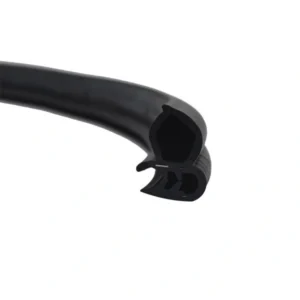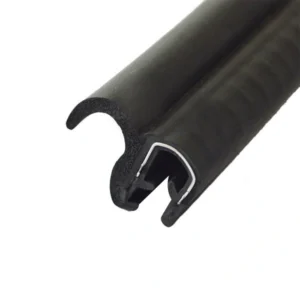Cars, machinery, and buildings are often exposed to external threats such as mechanical impacts and vibrations. One highly effective solution to protect against these hazards is the use of rubber pinch welds.
Rubber pinch weld seals serve a variety of functions—from protecting edges to absorbing shocks and providing waterproof sealing. In this article, we’ll explore their key uses and why they are essential across industries.
What Is a Rubber Pinch Weld?
A rubber pinch weld is a specialized sealing component designed to cushion, protect, and reinforce edges, seams, and exposed parts. Its primary role is to shield these vulnerable areas from external threats like mechanical impacts and vibrations.
Typically made from synthetic rubber, pinch weld seals feature either a hollow or solid core. For added strength, some designs incorporate metal or fabric reinforcements. Externally, they often have a ribbed surface to enhance grip and sealing performance. Internal grooves further facilitate secure attachment to surfaces.
There are several types of pinch weld seals commonly used in the rubber industry, including edge protectors, flap door seals, boot seals, and U-section bulb trims—each suited to specific applications.
Rubber Pinch Weld vs. Rubber Seal Strip: What’s the Difference?
While both rubber pinch welds and rubber seal strips are used for sealing purposes, they are designed with different goals in mind.
- Rubber pinch welds primarily focus on edge protection and cushioning. They are often found on vehicle doors, hoods, and windows, where a stronger, more complex structure is needed.
- Rubber seal strips, on the other hand, create tight seals between two surfaces to block out moisture, dust, air, or chemicals. These strips usually have a simpler structure and may come with adhesive backing for easy installation, commonly used in doorways, windows, and HVAC systems.
| Feature | Rubber Pinch Weld | Rubber Seal Strip |
| Purpose | Edge protection, reinforcement, cushioning | Creating a tight seal between surfaces |
| Structure | Complex, with flexible rubber and inserts | A simple, continuous strip of rubber |
| Reinforcement | Often reinforced with metal or fabric | It may or may not reinforced |
| Outer Surface | Ribbed or textured for grip | Uniform profile |
| Inner Surface | It may have grooves for attachment | Generally smooth |
| Application areas | Vehicle doors, hoods, windows | Automotive weatherstripping, door seal seals, HVAC |
| Installation method | Attached to a substrate with clips of fastened | Often features adhesive backing |
Key Applications of Rubber Pinch Welds
Rubber pinch welds are indispensable across a wide range of industries. Here are ten key applications where they play a critical role:
1. Edge Protection
Rubber pinch welds provide robust protection against damage caused by impact or abrasion along exposed edges. This not only prolongs the life of products but also enhances safety—for instance, by covering sharp sheet metal edges.

Common Uses:
- Automotive doors and windows
- Construction panels (metal or glass)
2. Sealing & Gasketing
Pinch welds create strong, reliable seals around edges, joints, and gaps, effectively blocking out water, air, dust, and noise. While similar to seal strips, pinch welds offer superior sealing along complex contours and moving parts.

Common Uses:
- Car doors and windows
- Building facades and machinery joints
3. Vibration Dampening
Machinery vibrations can lead to premature wear, operational inefficiencies, and discomfort. Rubber pinch welds help absorb and distribute vibrations, extending equipment lifespan and improving user comfort.
4. Shock Absorption
Rubber’s natural elasticity makes pinch welds excellent shock absorbers. They cushion impacts, sudden movements, and load changes, preventing damage and improving the overall safety and durability of systems.
5. Waterproofing
Pinch welds provide effective barriers against water ingress. Their flexibility ensures a tight fit over uneven surfaces, helping to protect sensitive equipment from corrosion, electrical faults, and mechanical failure.
Common Uses:
- Automotive weather seals
- Industrial enclosures
6. Sound Insulation
By absorbing and dampening sound waves, rubber pinch welds reduce noise transmission. They are ideal for improving acoustic comfort in vehicles, buildings, and industrial spaces.
7. Heat Insulation
Rubber pinch welds also help regulate temperatures by providing a thermal barrier. Different rubber formulations are available depending on the level of heat resistance required.
Benefits:
- Enhanced energy efficiency
- Improved safety and comfort
8. Dust Prevention
In environments where dust control is critical—such as electronics, manufacturing, and food processing—pinch welds create tight seals that prevent contamination and reduce maintenance needs.
9. Automotive Pinch Weld Edge Trims
In vehicles, pinch weld edge trims not only enhance aesthetics but also protect doors, trunks, hoods, and windows from damage.
Designed for durability, they withstand extreme temperatures, UV exposure, and environmental wear.

Pro Tip: Choose different styles of pinch weld trims based on specific locations and functional needs in a vehicle.
10. Gripping
Rubber pinch welds offer excellent grip and cushioning, providing a non-slip surface ideal for handling heavy or sharp-edged materials safely in industrial settings.
Conclusion
Rubber pinch welds are a critical component in protecting and enhancing the performance of cars, machines, and buildings. They offer vital benefits, including edge protection, waterproofing, shock absorption, vibration dampening, sound insulation, and more.
With various designs and material options available, selecting the right pinch weld seal requires careful consideration of your specific application needs.
At Okin Rubber, we specialize in manufacturing a wide range of high-quality rubber seal strips, including custom-engineered rubber pinch welds.
If you’d like more information or need assistance choosing the right product, don’t hesitate to contact our professional customer support team—we’re here to help!
